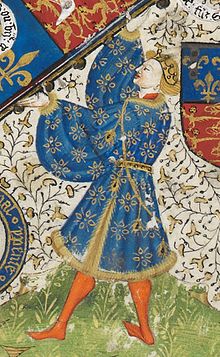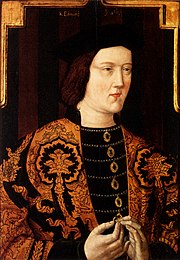Edward IV
Most of Normandy was recaptured by the French, leaving Calais as the last English possession in Northern France; Somerset, whom many held responsible for the losses, was appointed King Henry's chief minister.[10] Matters came to a head in August 1453 when King Henry VI collapsed into a catatonic stupor on hearing news of the loss of Gascony, an English possession for over 300 years.[4] The birth of King Henry VI's son, Edward of Westminster, Prince of Wales, in October 1453 created a viable Lancastrian figurehead, and the 1450s was dominated by political conflict between the two factions.[15] The implications of removing the legally accepted heir to the throne created substantial opposition to the Yorkist administration; in late 1460, Edward was given his first independent command and sent to deal with a Lancastrian insurgency in Wales.Warwick remained in London, while York, Salisbury, and Edmund marched north to suppress another in Yorkshire; all three were killed following defeat at Wakefield on 30 December, leaving Edward as the new head of the Yorkist party.[20] Estimates of the dead range from 9,000 to 20,000; figures are uncertain, as most of the mass graves were emptied or moved over the centuries, while corpses were generally stripped of clothing or armour before burial.[25] This exposed internal divisions, particularly over foreign policy, which in this period largely focused on the relationship between England, France and the Duchy of Burgundy, with two of the parties manoeuvring to form an alliance against the third.[27] In October 1464, Warwick was enraged to discover that on 1 May, Edward had secretly married Elizabeth Woodville, a widow with two sons, whose Lancastrian husband, John Grey of Groby, died at the Second Battle of St Albans.Warwick responded by building an alliance with Edward's disaffected younger brother and heir, the Duke of Clarence, who held estates adjacent to the Neville heartland in the north.The three men issued a 'remonstrance', listing alleged abuses by the Woodvilles and other advisors close to Edward and then returned to London, where they assembled an army to remove these 'evil councillors' and establish good government.In early 1470, Edward reinstated Henry Percy as Earl of Northumberland; John was compensated with the title Marquess of Montagu, but this was a significant demotion for a key supporter.[39] Seeing an opportunity, Louis XI persuaded Warwick to negotiate with his enemy, Margaret of Anjou; she eventually agreed, first making him kneel before her in silence for fifteen minutes.[41] By now, the Yorkist regime was deeply unpopular and the Lancastrians rapidly assembled an army of over 30,000; when John Neville switched sides, Edward narrowly escaped capture and was forced to seek refuge in Bruges.[42] Edward took refuge in Flanders, part of the Duchy of Burgundy, accompanied by a few hundred men, including his younger brother Richard, Duke of Gloucester, Anthony Woodville and William Hastings.Supporters were reluctant to join him; the important northern city of York opened its gates only when he claimed to be seeking the return of his dukedom, like Henry IV seventy years earlier.Clarence was widely suspected of involvement, a factor in his eventual execution in the Tower on 18 February 1478; claims he was "drowned in a butt of Malmsey wine" appears to have been a joke by Edward, referring to his favourite drink.[54] Edward's health began to fail, and he became subject to an increasing number of ailments; his physicians attributed this in part to a habitual use of emetics, which allowed him to gorge himself at meals, then return after vomiting to start again.[65] Economics was closely linked to foreign policy; Edward's reign was dominated by the three-sided diplomatic contest between England, France, and Burgundy, with two of the three seeking to ally against the third.The death of Charles in 1477 led to the 1482 Treaty of Arras; Flanders, along with the lands known as the Burgundian Netherlands, became part of the Holy Roman Empire and France acquired the rest.He acquired fine clothes, jewels, and furnishings, as well as a collection of beautifully illuminated historical and literary manuscripts, many made specially for him by craftsmen in Bruges.[76] Edward spent large sums on Eltham Palace, including the extant Great Hall, the site of a feast for 2,000 people in December 1482, shortly before his death in April.[77] He also began great improvements to St George's Chapel, Windsor, where he was buried in 1483; later completed by Henry VII, it was badly damaged during the First English Civil War, and little of the original work remains.The most famous was Jane Shore, later compelled by Richard III to perform public penance at Paul's Cross; Thomas More claimed this backfired, since "albeit she were out of al array save her kyrtle only: yet went she so fair & lovely ... that her great shame wan her much praise.[90][91] Both Eleanor and Edward were dead, but according to Philippe de Commines, Robert Stillington, Bishop of Bath and Wells, claimed to have carried out the ceremony himself.









Edward IV (play)King of Englandmore...CoronationHenry VIEdward VNormandyFranceWestminsterEnglandSt George's Chapel, Windsor CastleElizabeth WoodvilleElizabeth, Queen of EnglandMary of YorkCecily, Viscountess WellesEdward V, King of EnglandMargaret of YorkRichard, Duke of YorkAnne, Lady HowardGeorge, Duke of BedfordCatherine, Countess of DevonBridget of YorkArthur, Viscount LisleRichard of York, 3rd Duke of YorkCecily NevilleWars of the RosesYorkistLancastrianYorkist claim to the throneBattle of WakefieldMortimer's CrossTowtonKing Henry VIRichard Neville, Earl of WarwickGeorge, Duke of Clarencere-installed Henry VIFlandersBarnetTewkesburyEdward of Westminster, Prince of WalesTower of LondonHenry TudorHundred Years' WarLouis XITreaty of PicquignyLord ProtectorEdward V and his younger brother disappearedRichard IIIRichard, 3rd Duke of YorkEarl of MarchKing Edward IIIHumphrey, Duke of GloucesterMargaret, Duchess of BurgundyKing Richard IIIEdmund, Earl of RutlandHenry Beaufort, 3rd Duke of SomersetLudlow CastleWelsh Marcheschief governor of IrelandCalaisHouse of LancasterWilliam de la Pole, 1st Duke of SuffolkMargaret of AnjouGasconyRichard Neville, 5th Earl of SalisburyRichard Neville, 16th Earl of WarwickGreat CouncilBattle of Ludford BridgeEnglish ChannelNorthamptonPalace of WestminsterAct of AccordYorkshireWakefieldBattle of TowtonPhilippe de ComminesBattle of Mortimer's CrossHerefordshireparhelionSun in splendourSecond Battle of St AlbansJohn NevilleBattle of HexhamDuchy of BurgundyLouis XI of FranceAnne of FranceBona of SavoyJohn Grey of GrobyJacquetta of LuxembourgRichard Woodville, Lord RiversPrivy CouncilCatherine of ValoisOwen TudorJean de WavrinCatherine WoodvilleHenry Stafford, 2nd Duke of BuckinghamAnne WoodvilleHenry Bourchier, 1st Earl of EssexEdmund Grey, 1st Earl of KentLord ChancellorGeorge Neville, Archbishop of YorkIsabelEdgecote MoorMiddleham CastleJohn WoodvilleKenilworthHenry PercyEarl of NorthumberlandMarquess of Montagu1470 Lincolnshire RebellionBrugesEdmund Beaufort, 4th Duke of SomersetCharles the Boldrestored Lancastrian regimehis fatherHenry IVWilliam ParrJames HarringtonBattle of BarnetBattle of TewkesburyAnne NevilleCountess of WarwickJohn de Vere, 13th Earl of OxfordBosworthMalmseySiege of Neuss
